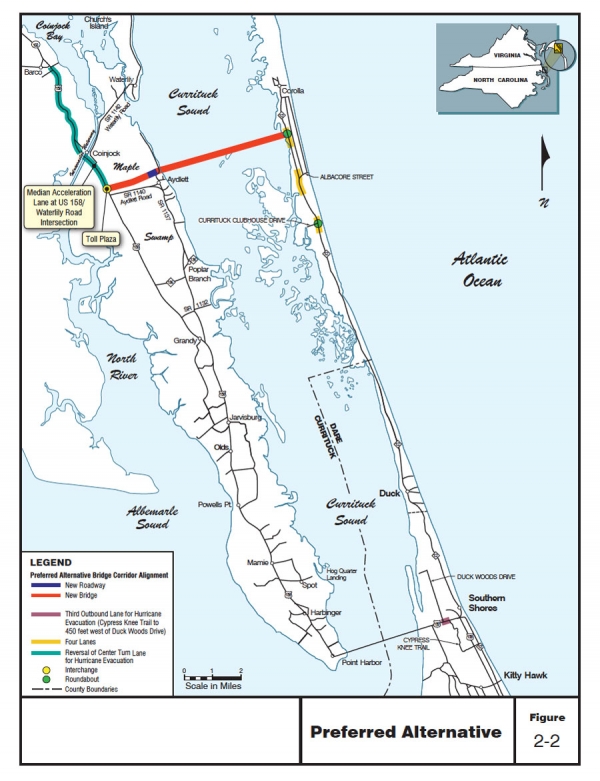Mid-Currituck Bridge delayed; new traffic forecasts show bridge not needed
The schedule for constructing the controversial Mid-Currituck Bridge—an expensive and environmentally destructive seven-mile toll-bridge that would connect the Outer Banks town of Corolla with mainland Currituck County—has been delayed again. Last week, the North Carolina Department of Transportation confirmed that the project’s schedule was pushed back as the agency continues to study the need for the bridge and the viability of alternative solutions after new data showed a drastically reduced traffic forecast. Less than a year ago, the governor announced that the bridge project had been accelerated and construction would begin in the summer of 2017.
Representing a group of local citizens opposing the bridge, SELC welcomed the news that NCDOT will not rush forward with the $678 million project.
“We’re encouraged that NCDOT is taking the time to consider whether the Mid-Currituck Bridge is really the best transportation solution for Currituck County,” said Staff Attorney Kym Hunter. “If NCDOT really takes a thorough look at this project based on current data, we’re convinced that they’ll conclude it’s a long-outdated idea that would waste the area’s transportation dollars while causing significant environmental harm.”
New data obtained by SELC from NCDOT suggests that the delay might stem from questions about the need for the bridge and its financial viability. The new data show that future traffic volumes on the Northern Outer Banks are now estimated to be significantly lower than previously anticipated by NCDOT—in some instances almost half of earlier estimates.
The new data raise serious concerns about the fiscal burden that will be placed on taxpayers if NCDOT moves ahead with the bridge. The bridge ranked low under the state transportation scoring system and only $173 million has been set aside to pay for the costly project. New estimates, however, place the expected cost of the bridge at up to $678 million—meaning that over $500 million may need to be covered by drivers paying tolls. With the new traffic numbers showing dramatically lower expected usage of the bridge it seems unlikely this revenue will materialize, raising questions as to who will pick up the tab. So far, NCDOT has failed to present any financial path forward for the project.
“Not only will the Mid-Currituck Bridge destroy the character of Currituck County, it will place an immense financial burden on coastal taxpayers” said Jen Symonds, leader of NoMCB, a local citizens group that has long opposed the bridge. “NCDOT’s new numbers confirm what we’ve been saying for years—the bridge is a colossal waste of taxpayer money. Coastal residents, visitors and taxpayers would be better served by smart, focused improvements to the existing highway system.”
When NCDOT last studied the bridge, tolls were estimated to be as high as $26 for a one-way trip. Now that estimated use of the bridge has diminished so significantly tolls might need to be as high as $50 per trip to come close to paying for the pricey project.
Traffic projections for the proposed Mid-Currituck Bridge recently dropped dramatically, raising important questions about the need for this expensive, environmentally-damaging project. (@NCDOT)
Cutting across Currituck Sound
